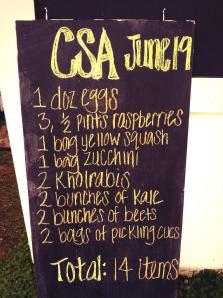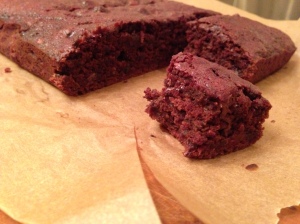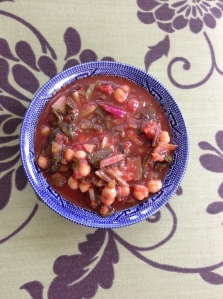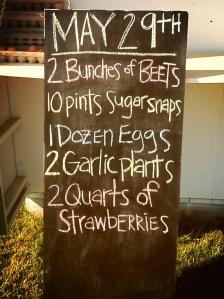In this week’s box:
3 pounds of green beans
1/2 dozen eggs
3 pounds of potatoes
2 bunches of green onions
2 bunches of beets
2 bunches of swiss chard
14 ears of bicolor corn(white and yellow on the same cob)
1 head of broccoli
1/2 pint of raspberries
1 pint of blackberries
1 bag of tomatoes
Retail value of this week’s box: $46
Total retail value of goods distributed so far this season: $472
Emily’s notes:
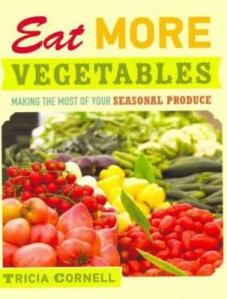 On a recent trip to the library, I stumbled upon a cookbook that I think would make a great reference in any CSA member’s kitchen. It’s called, “Eat More Vegetables” by Tricia Cornell, and was published in 2012. Cornell, who lives in Minnesota, is a longtime CSA member. She writes about how the weekly box of produce was overwhelming for her for the first few years of membership, and she even dreaded CSA pickup days at times because of the volume that came into her kitchen. But over the years she developed rhythms and devised dishes that made it all a lot more manageable and enjoyable for her entire family. There are some really creative recipes in here that look like a lot of fun. I think I might have to make an exception to my self-imposed ban on buying new cookbooks to add this one to the home library.
On a recent trip to the library, I stumbled upon a cookbook that I think would make a great reference in any CSA member’s kitchen. It’s called, “Eat More Vegetables” by Tricia Cornell, and was published in 2012. Cornell, who lives in Minnesota, is a longtime CSA member. She writes about how the weekly box of produce was overwhelming for her for the first few years of membership, and she even dreaded CSA pickup days at times because of the volume that came into her kitchen. But over the years she developed rhythms and devised dishes that made it all a lot more manageable and enjoyable for her entire family. There are some really creative recipes in here that look like a lot of fun. I think I might have to make an exception to my self-imposed ban on buying new cookbooks to add this one to the home library.
When I picked up this book, I was thinking about beets, which also appear in this week’s box. Cornell’s recipe for Beet and Goat Cheese Tart looked intriguing to me. I’m going to be entertaining guests this week, so I might give it a try. Here it is:
Beet and Goat Cheese Tart
Serves 8 as an appetizer
1 pound beets
1/2 cup plain yogurt
1 egg
6 ounces goat cheese
1 sheet frozen puff pastry, thawed
olive oil
1 to 2 tablespoons honey (optional)
1 teaspoon dried sumac (This is a Middle-Eastern spice that Cornell says is optional, but adds a nice tartness.)
Wrap beets in foil and roast at 400 degrees until a knife slides easily all the way through (This took about an hour with the beets we got last week.). You want beets on the softer rather than firmer side for this recipe. Leave the oven on. Peel the beets under running water as soon as they are cool enough to handle. Slice them 1/4 inch thick.
Mix yogurt, egg and goat cheese. Place pastry on lightly floured or parchment-lined baking sheet. Brush very lightly with olive oil. Cover pastry with overlapping disks of beets, leaving about 1 inch around the edges. Spoon goat cheese mixture over the top, still leaving the edges clear. Drizzle with honey (I am thinking balsamic vinegar might be a good alternative here.) and bake 35 to 40 minutes, until edges are puffed and golden brown. Cool completely, then slice into 2-inch squares and serve.
If you’re looking for more beet ideas, the beet salad described in this post on the blog “Dinner: A Love Story” looks nice to me. I also might have to make this beet hummus that has been on my to-do list for years, but never seems to get made before I use my beets for something else. Like cake.
With onions, green beans and potatoes in this week’s box, you’re all set up to make a classic Southern side, green beans and new potatoes. This recipe from the blog Deep South Dish gives a good guide. I can smell the bacon now.
On a busy night, I sometimes like to roast my green beans. They don’t get as soggy, and the flavors of what you dress them in intensify a bit. The last time we got green beans, I roasted them after tossing them with a mix of sesame oil, soy sauce, rice vinegar and brown sugar, with a sprinkling of sesame seeds. This recipe for parmesan roasted green beans from the blog Skinny Taste looks like something I’ll have to try with this batch.
And the first corn of the season is here! Last year I discovered that the best way to get corn on the table quickly on a weeknight was to toss it in the microwave, husk and all, and cook for about 3 minutes per ear (exact time will vary based on your microwave’s power). Remove it with a potholder (It’s hot!) and hack off the end that was attached to the stalk. Then you should be able to shake the cooked ear of corn straight onto your plate without having to deal with those pesky silks. It’s not quite as good as roasting corn in an oven (also with husks on) or grilling it, but it’s pretty good for a quick weeknight technique, which is what I need most of the time these days.
You could combine fresh corn taken off the cob with chopped tomates and onions from this week’s box for a quick fresh salsa. Toss the mixture with a little olive oil, lemon or lime juice, salt, pepper and cilantro (if you like it). Dice some of the potatoes and serve them hash-brown style, and scramble a few of the eggs. Spoon your salsa over the potatoes and eggs and you have a really tasty dinner completely from your CSA box!
You can click the “Swiss Chard” tag at right to see all the recipes we’ve linked to for chard so far this year. I am thinking of using my pizza dough recipe to make a chard calzone this week. I’ll share the recipe if it turns out!
This far into the season, I’d love to hear your thoughts on this blog. Are the recipes useful? Do they fit your lifestyle? Are there vegetables that you need more ideas for? Please e-mail me here with your comments (I will specify that I am asking for comments about the blog itself. Questions about CSA pickup should be directed to the Sneads.)


